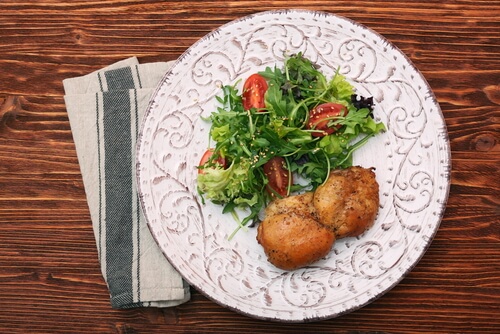Whenever I talk about foods that can help control your hunger, I’m aware of the fact that hunger is only one if the things that drive us to eat. Frequently, we eat simply because it’s time to eat, or because food is present, or because we’re bored, or blue, or procrastinating. I’d even go so far as to say that, for many of us, hunger is only rarely our primary motivation for eating.
If we only ate when we were hungry, then choosing foods that are good at satisfying hunger (such as those that are high in protein, fiber, and water) would pretty much solve the problem of overeating. But because we so often eat (and overeat) when we’re not hungry, we also need strategies that address non-hunger eating.
This week, I have four strategies that can help you avoid mindless eating and overeating.
Mindful Eating Tip #1: Only Eat
Just as distracted driving is responsible for a huge number of traffic accidents, distracted eating is the culprit in a lot of overeating. Eating in front of the computer or TV, in the car, while reading, or any other time when your attention is elsewhere is an easy way to lose track of what and how much you’ve eaten.
I’m as guilty of this as anyone else. When eating lunch by myself, I always want to grab a newspaper to read or scroll through my Facebook feed while I’m eating. If I get hungry while I’m working, I’m tempted to bring a snack back up to my office so that I can keep working while I nosh.
But when most of our attention is on something else while we’re eating, we barely taste our food. We get very little enjoyment out of it. We’re not in touch with how much we’ve eaten. And worst of all, because we’re not at all tuned in to our bodies, we’re more likely to keep eating past the point at which our hunger is satisfied.
The solution is simple: When you’re eating, only eat. Turn off the TV. Step away from your desk. Put down your phone. Give all of your attention to your meal and the experience of eating it. Something that you’d eat mindlessly while staring at your screen might suddenly strike you as not worth the calories once you’re actually paying attention. If just eating isn’t entertaining enough for you, maybe you’re actually not that hungry!
I don’t mean to imply that you always have to eat alone—or completely ignore your dining companions—in order to eat mindfully. Eating with others can divert some of your attention away from what you are eating and how you feel while eating it. But sharing a meal is one of life’s great pleasures—and it needn’t come at the expense of mindful eating. The next two tips can help you eat mindfully even when eating with other people.
Mindful Eating Tip #2: Mind the First Bite
Last fall, I went on a Mindfulness Retreat and at the retreat center I attended, meals are consumed in complete silence, in order to promote truly mindful eating—with every bite given our full attention. Although it was an illuminating exercise, eating all of your meals in complete silence isn’t really practical in real life. But you can get a lot of benefit simply from giving the first bite of every meal or every food your complete attention.
This tip is actually from Chade Meng Tan, best known as Google’s in-house mindfulness guru. In his book, Joy on Demand, he talks about tuning in to the “thin slices of joy” in everyday life as a way of increasing our overall happiness and contentment.
Research has shown that the very first bite or sip of a tasty food or beverage is the most rewarding, with every subsequent bite or sip delivering a diminishing amount of pleasure. So Tan’s tip is really designed to help you pay attention to the most pleasurable moment of every meal.
But really tuning into the very first bite of every food you eat can also help ensure that the decision to begin eating is an intentional one, as opposed to a reflexive or even unconscious response.
How often have you walked by a dish of candy and popped one in your mouth without even stopping to consider whether you even like that kind of candy? Or walked into the kitchen and grabbed a bit of whatever was sitting on the counter or table, just because it was there? Five minutes later, and you might not even remember having eaten it!
If you can train yourself to give your complete attention to the first bite of every food, the decision to eat something will always be a conscious choice. You’ll also notice how much pleasure you do or don’t get from it. Try this for a week and watch what happens!
Mindful Eating Tip #3: Mouth Full/Fork Empty
This genius tip comes from Darya Rose, who has lots of great insights about mindful eating in her book, Foodist, and in her blog on SummerTomato.com. Darya noticed that, after taking a bite of her meal, she immediately began loading the next bite onto her fork while she still was chewing. After she pointed this out, I realized that I do the same thing.
Darya implemented a simple rule for herself that I highly suggest adopting for yourself: If there is food in your mouth, there shouldn’t be food on your fork. Wait until you’ve finished chewing and swallowing whatever is in your mouth before beginning to compose the next forkful. This simple habit can be game-changing!
If there is food in your mouth, there shouldn’t be food on your fork.
For one thing, it will tend to slow you down, which can help prevent overeating. You’ll also have a more vivid experience of the food because it helps keep you focused on the bite you’re currently enjoying rather than the one that’s coming up next. I also like this practice because it can help you eat more mindfully without impairing your ability to enjoy the company of your dining companion.
Mindful Eating Tip #4: Create a Meal-Ending Ritual
The meal is over. We’ve finished what’s on our plate and are feeling pleasantly full. But somehow our brain doesn’t get the memo that the eating occasion has ended. And so we continue to mindlessly graze. We snack on leftovers while cleaning up, or pour another inch or three of wine into our glass. On our way out of the kitchen, we might even open up the cupboard to see what’s in there—despite having just eaten!
To stop this tendency, develop a ritual that clearly signals to your brain that the meal or snack is now complete. You might brush your teeth, or wash your hands and apply a scented hand lotion. You could chew a piece of gum while you do the dishes. (Wine tastes terrible after gum!) There’s even a brand of after-dinner mint called Meal-Enders, designed specifically for this purpose.
Whatever your meal-ending ritual is, the more consistently you invoke it, the more effective it will be. Your brain will come to associate that particular activity or sensation with the cessation of eating.
It’s the same trick I used to develop my now-ingrained morning exercise habit. I’ve trained myself to put on my gym clothes as soon as I finish my cup of coffee. And once I’ve got my gym clothes on, going to the gym is automatic. It’s gotten to the point that I don’t even consciously think about it anymore. When I see the bottom of my cup, my brain instantly pictures my running shoes. It’s weird. But it works!
This Week: Mindfulness on the Menu
You could implement one or two of these mindful eating strategies or all four. But try to stick with it for at least a week. Then, tell me what you think. Did any of these tips help you avoid or reduce mindless eating? Which ones had the biggest impact? Did eating more mindfully increase your enjoyment of food? What did you learn about your eating habits? Post your thoughts below or on the Nutrition Diva Facebook page. I’m really looking forward to hearing the results of your experiments!
More questions? Send an email or post your question on the Nutrition Diva Facebook page. Then, be sure to subscribe to the Nutrition Diva podcast on iTunes, Stitcher, or wherever you listen, so don’t miss a single episode!
Image courtesy of Shutterstock.





